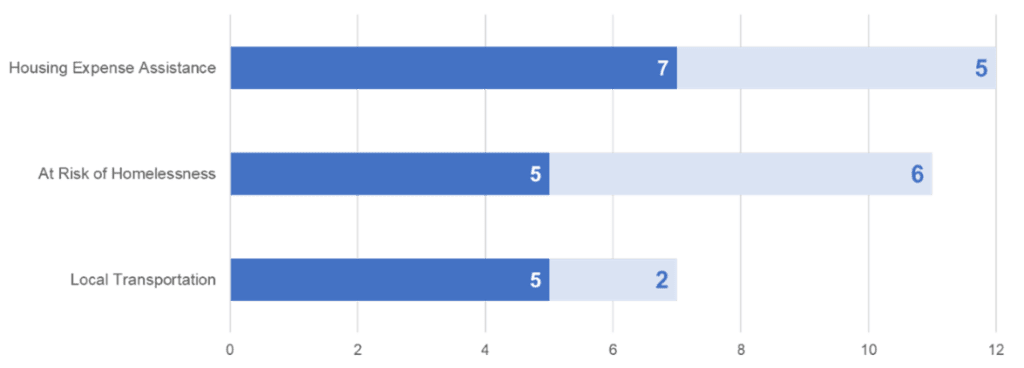Community Focus: An inventory of existing research
Rather than duplicate efforts with another community assessment, UWM initiated our research by strategically gathering and inventorying 26 existing research and planning documents, recognizing the wealth of information already available. This approach allowed us to leverage the insights and data accumulated over time by various entities within the Omaha-Council Bluffs metro. In doing so, this methodological choice reflects our commitment to efficiency and resource optimization. By systematically cataloging and evaluating diverse sources, we developed a more comprehensive understanding of the areas where our community is focusing its attention.
The inventory process sought to identify the topics of greatest relevance to the metro area by cataloging inclusion of various basic needs, education and financial stability services, as well as crime, infrastructure and more than 100 other focus areas. Beyond mere identification, our team also assessed the extent to which these community needs were mentioned or prioritized in the respective documents. This dual-layered approach allowed us to not only quantify the prevalence of specific needs but also gauge their relative importance in the existing assessments.
Not surprisingly, housing replaced transportation as the issue with the most community attention.
Across 26 research studies and planning efforts, housing expense assistance and homelessness were the two most frequently prioritized topics. Consistent prioritization and mention across multiple studies suggests a shared recognition among various stakeholders of the Omaha-Council Bluffs area regarding the critical importance of these issues.
A combination of low inventory, unsafe properties, high rent and escalating housing prices are driving residents to housing instability and homelessness. The affordable housing crisis is real, widespread and continues to persist. For more on our analysis of the housing environment, click here.
Top 3 Topics Prioritized or Referenced Across 2X Community Studies
Number of studies prioritizing or referencing topics

LEGEND
Priority
Reference
Other focus areas include public schools and districts, general medical care and food, as well as public safety and environmental protection.
It comes as no surprise that transportation is still among the most visible topics in our community. The need to connect people with critical destinations across our community remains a priority because it has the power to transform our economic, health, social and cultural well-being. Further, a healthy and vibrant community depends on a healthy transportation ecosystem. In UWM’s 2021 and 2013 studies, transportation was cited as the top community need. Today, local studies and planning efforts recognized the historical limitations of our transportation system, but also referenced cross-sector collaborations to improve both infrastructure and public options – with big solutions on the horizon. Yet as long-term efforts to improve transportation continue to develop and come to fruition, transportation remains a significant community need.
Public schools and school districts were also prioritized in several assessments, particularly in relation to addressing disparities among students and providing upstream, early interventions that help individuals on the path to financial stability. General medical care and food access were also prioritized with similar frequency. This underscores the critical and persistent nature of healthcare and food-related challenges within the Omaha-Council Bluffs metro, particularly as these concerns were elevated in 2021 and 2013 studies. Prioritization of these topics likely stems from an understanding that health and education is integral to overall community resilience.
Interestingly, environmental protection and public safety were also prioritized and mentioned in several studies. These priorities suggest the significance of secure communities and a common understanding that a safe and secure environment is fundamental to the overall well-being and quality of life for residents.
Our findings from this inventory not only served as a valuable baseline but also guided additional lines of inquiry, enabling us to delve deeper into specific areas or emerging trends identified through the existing assessments.
The Housing Crisis at Home:
Read more about where progress is happening and the availability of UWM supports.
Read MoreTransportation remains a critical community need:
Read more about where progress is happening and the availability of UWM supports
Click HereUnderstanding Nebraska's Health Needs:
Read more about the health needs identified across studies, as well as through our analysis of 211 Helpline data.
Read MoreSources
ACT: The Conditions of College and Career Readiness. 2019.
City of Omaha: Action Plan. 2022.
College of Public Health, University of Nebraska Medical Center: Key Findings That Highlight Connections Among Early Childhood Development, Families and Communities. 2023.
Creighton Social Science Lab and Together: Evictions in Nebraska During Covid-19. 2021.
Douglas County Strategic Plan, 2023-2025.
Greater Omaha Area Chamber of Commerce: Housing Data Book. 2022.
Greater Omaha Area Chamber of Commerce: The Barometer. 2021.
Greater Omaha Area Chamber of Commerce: Urban Core Strategic Plan. 2022.
Heartland 2050: 2019 Action Plan MAPA 2050 Long Range Transportation Plan. 2020.
Mentor Nebraska: Mapping Summary, 2021 and 2023-2025 Strategic Plan.
MetroNext: Better Transit for a More Connected Region, Executive Summary. 2022-2030.
Voices for Children: Nebraska Kids Count, 2019.
North Omaha Recovery Plan, 2022-2025.
Omaha City Planning: Omaha Housing Affordability Action Plan. 2022.
Omaha Housing Authority: Southside Terrace Assessment. 2020.